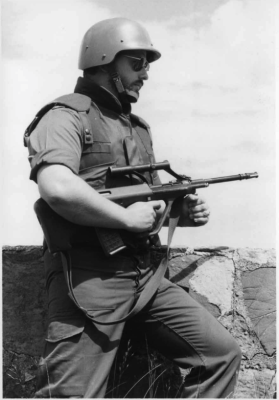AN AUG STORY: BIRTH OF A BULLPUP

The year is 1963. Colonel Walter Stoll of the Austrian Armed Forces is tasked by his superiors with building or finding a less punishing round to field among their army units, and the firearm to deliver it downrange. Despite the popularity of the Steyr StG 58, chambered in 7.62x51mm NATO, it was a lot more gun than most soldiers needed—and certainly more recoil than some could easily handle. Unsatisfied with the short “Stoll” cartridges his group initially created, the colonel found what he was looking for in America. Colt had just released their brand-new AR-15 rifle in the fast but manageable .223 Remington. Stoll knew he could harness that quicksilver caliber but in a simpler, more compact, and reliable platform than the ArmaLite, something tough enough to endure the rigors of the Austrian Alps.
Steyr Arms’ engineering department, a hand-in-glove partner of the Austrian Military for nearly a century at that point, completed development of the SSG sniper rifle in 1969, freeing capacity for creation of a new system. Technological Councilor Karl Wagner commenced the Armee Universal Gewehr (Universal Army Rifle or AUG) project soon thereafter, alongside engineers Horst Wesp and Karl Möser, several military officials were stationed at the main Steyr plant to collaborate on the project.

This collection of visionaries produced their first prototype in 1970, which included quickly exchangeable barrels but maintained the StG 58’s magazine insert in the grip. Stoll felt this was an awkward shape, so they moved the magazine and action reward of the firing controls, adopting a then-mostly theoretical concept of a bullpup rifle – so named by British firearms developers in the 1930s who considered the design to be “squat, ugly but still aggressive and powerful,” according to historian Jonathan Ferguson.

The Austrian effort in this vein blossomed into something anything but ugly. Dozens of prototypes eventually arrived at an extremely compact design with a center of gravity set back toward the shooter. It included a longer barrel than most AR-15 models but with a shorter length overall. And that barrel could be swapped quickly and without tools or a vise, allowing the shooter to seamlessly jump between calibers to suit various operational needs. Its short-stroke gas piston system provided unmatched reliability and simplicity even in rugged environments.

While it was not the first bullpup rifle, the Sturmgewehr (StG) 77 was the first widely adopted and fielded. Acceptance among the Austrian Federal Army was immediate because the gun was so easy to teach and maintain. Commanders could hand an AUG to a conscript on their first morning of training and expect the recruit to be shooting it accurately and cleaning it efficiently by that evening. They found it ideal for combat in tight environments, while the barrel specs and ballistics still allowed for long shots when needed. Along with an integrated optic, translucent magazine, and stunningly easy assembly, the gun simply did what a standard-issue field weapon needed to do.

Numerous iterations, models, and adaptations over the decades have continued to refine this iconic weapon for combat units and civilian purposes, culminating with the latest, greatest AUG A3 M2. Australia, Ireland, New Zealand, Argentina, and many other militaries have adopted the platform over the decades, followed in suit by dozens of law enforcement agencies around the globe, including some in the United States.
The Austrian engineering team didn’t design their AUG for Hollywood, but directors seized upon it immediately. Dozens of films and shows feature this firearm, from Predator to Robocop to Point Break and several James Bond films, but none perhaps more famous than everyone’s favorite Christmas movie: Die Hard. The timeless design simply feels as futuristic in 2024 as it did in 1977 and 1988.
As we creep toward 50 years of the AUG, we celebrate not only a weapon but a legacy of innovation and excellence in firearms history.
